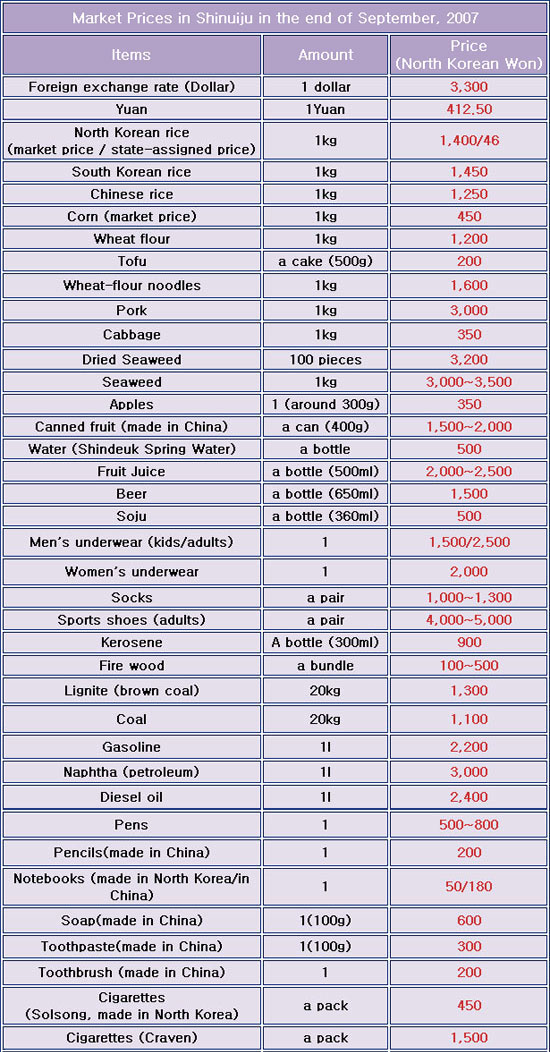Daily NK
Lee Sung Jin
10/19/2007
 A study reveals that market prices have skyrocketed in North Korea since the massive flood disaster in August.
A study reveals that market prices have skyrocketed in North Korea since the massive flood disaster in August.
According to the study conducted by DailyNK in late September this year, the rice price in the northern part of North Korea increased by 500 North Korean won on average between early July and September. In the market in Sinuiju of North Pyongan Province, the rice price rose from 980 Won/kg to 1,400 Won/kg.
The price of imported rice from China also went up to 1,250 won/kg. The rice from South Korea was sold at 1,450/kg. In Gwaksan of North Pyongan Province, the domestic rice was sold at 1,370/kg, the rice from China at 1,500/kg, the rice from South Korea at 1,300/kg.
In Hoiryeong of North Hamkyung Province, the price of domestic rice was 900 won/kg in July but rose to 1,250 won/kg. In Kilju of North Hamkyung Province, the domestic rice was sold at 1,200 won/kg. This shows that the rice price in North Hamkyung Province did not increase as highly as the price in Sinuiju of North Pyungan Province. In Hoiryeong, the price of rice has been rising steadily from 820 won/kg in March.
The rice in Hoiryeong is cheaper than in Sinuiju because demand for corn is relatively high and food distribution is partly being operated in Hoiryeong.
Between July and late September, the price of wheat also rose from 900 won to 1,200 won, and the price of noodles from 1,000 won to 1,600 won. However, the price of whole corn, the staple food for the low-income families remained stable for the same period.
It was believed that the surge in food prices resulted from the massive flood damage which stroke North Korea in early and middle August. When vast areas of land in South Pyongan and Hwanghae Province, the major granary of North Korea, were submerged during the flood, it was expected that domestic crop production would decrease.
After the food crisis in 1990s, the demand for rice increases in every fall during which rice price is low and people tend to purchase in advance one-year supply for food. In this fall, however, the price of rice greatly rose because the shortage of food was anticipated.
Meanwhile, the surge in rice price illustrates that overseas food aid was not distributed to the people of North Korean. The illicit sale of rice originally distributed to the party cadres or People’s Army has not been fully activated in the market. In addition, the rise in rice price was triggered by the fact that the number of wholesalers stocking up rice in advance increased with the news that there would be a shortage of food.
In early August, the price of rice once surged to a high of 1,950 won/kg in the market in Sinuiju. Thereupon, there was a rumor going around that the rise in rice price resulted from the state’s ban on rice sale and had nothing to do with the flood. Anyhow, the rice price has been on the decrease since then, and in September it had remained at around 1,500 won/kg.
As opposed to the rise in rice price, the price of corn, the main diet for the low-income families remained stable. This means the possibility of massive starvation in North Korea is low this year. Moreover, that the corn price remained moderate when rice price went up by 500 won reflects that the economic situation of middle class has been stabilized over the years.
Along with the rise in food prices, the prices of industrial products or others have been soaring sharply. The price of pork increased from 2,300 won/kg to 3,000 won/kg, and the price of frozen Pollack from 3,500/fish to 4,800/fish
The prices of brown seaweed or fruit juice went up to around 2,000 won each. The price of the popular imported cigarettes, Cat, rose by 200 won being sold at a cost of 1,500 won.
As winter is coming soon, the heating fuel price increased. Brown coal was sold at a cost of 1,300 won for 20 kg, gasoline at a cost of 3,000 won/liter
The exchange rate also increased from one dollar to 3,100 won to one dollar to 3,300 won.
